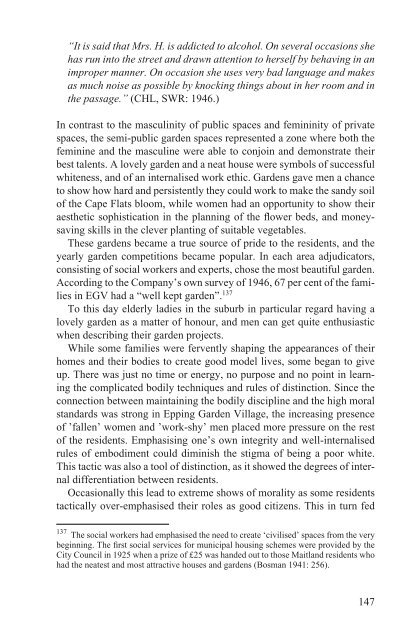The Making of a Good White - E-thesis - Helsinki.fi
The Making of a Good White - E-thesis - Helsinki.fi
The Making of a Good White - E-thesis - Helsinki.fi
You also want an ePaper? Increase the reach of your titles
YUMPU automatically turns print PDFs into web optimized ePapers that Google loves.
“It is said that Mrs. H. is addicted to alcohol. On several occasions she<br />
has run into the street and drawn attention to herself by behaving in an<br />
improper manner. On occasion she uses very bad language and makes<br />
as much noise as possible by knocking things about in her room and in<br />
the passage.” (CHL, SWR: 1946.)<br />
In contrast to the masculinity <strong>of</strong> public spaces and femininity <strong>of</strong> private<br />
spaces, the semi-public garden spaces represented a zone where both the<br />
feminine and the masculine were able to conjoin and demonstrate their<br />
best talents. A lovely garden and a neat house were symbols <strong>of</strong> successful<br />
whiteness, and <strong>of</strong> an internalised work ethic. Gardens gave men a chance<br />
to show how hard and persistently they could work to make the sandy soil<br />
<strong>of</strong> the Cape Flats bloom, while women had an opportunity to show their<br />
aesthetic sophistication in the planning <strong>of</strong> the flower beds, and moneysaving<br />
skills in the clever planting <strong>of</strong> suitable vegetables.<br />
<strong>The</strong>se gardens became a true source <strong>of</strong> pride to the residents, and the<br />
yearly garden competitions became popular. In each area adjudicators,<br />
consisting <strong>of</strong> social workers and experts, chose the most beautiful garden.<br />
According to the Company’s own survey <strong>of</strong> 1946, 67 per cent <strong>of</strong> the families<br />
in EGV had a “well kept garden”. 137<br />
To this day elderly ladies in the suburb in particular regard having a<br />
lovely garden as a matter <strong>of</strong> honour, and men can get quite enthusiastic<br />
when describing their garden projects.<br />
While some families were fervently shaping the appearances <strong>of</strong> their<br />
homes and their bodies to create good model lives, some began to give<br />
up. <strong>The</strong>re was just no time or energy, no purpose and no point in learning<br />
the complicated bodily techniques and rules <strong>of</strong> distinction. Since the<br />
connection between maintaining the bodily discipline and the high moral<br />
standards was strong in Epping Garden Village, the increasing presence<br />
<strong>of</strong> ’fallen’ women and ’work-shy’ men placed more pressure on the rest<br />
<strong>of</strong> the residents. Emphasising one’s own integrity and well-internalised<br />
rules <strong>of</strong> embodiment could diminish the stigma <strong>of</strong> being a poor white.<br />
This tactic was also a tool <strong>of</strong> distinction, as it showed the degrees <strong>of</strong> internal<br />
differentiation between residents.<br />
Occasionally this lead to extreme shows <strong>of</strong> morality as some residents<br />
tactically over-emphasised their roles as good citizens. This in turn fed<br />
137 <strong>The</strong> social workers had emphasised the need to create ‘civilised’ spaces from the very<br />
beginning. <strong>The</strong> <strong>fi</strong>rst social services for municipal housing schemes were provided by the<br />
City Council in 1925 when a prize <strong>of</strong> £25 was handed out to those Maitland residents who<br />
had the neatest and most attractive houses and gardens (Bosman 1941: 256).<br />
147
















